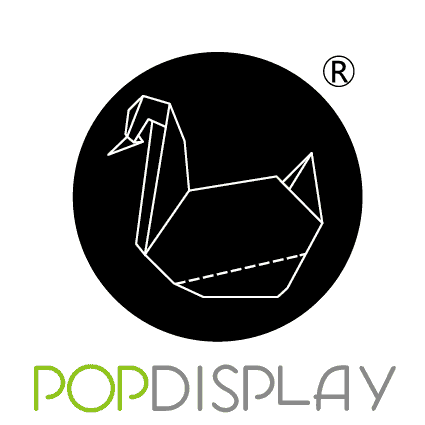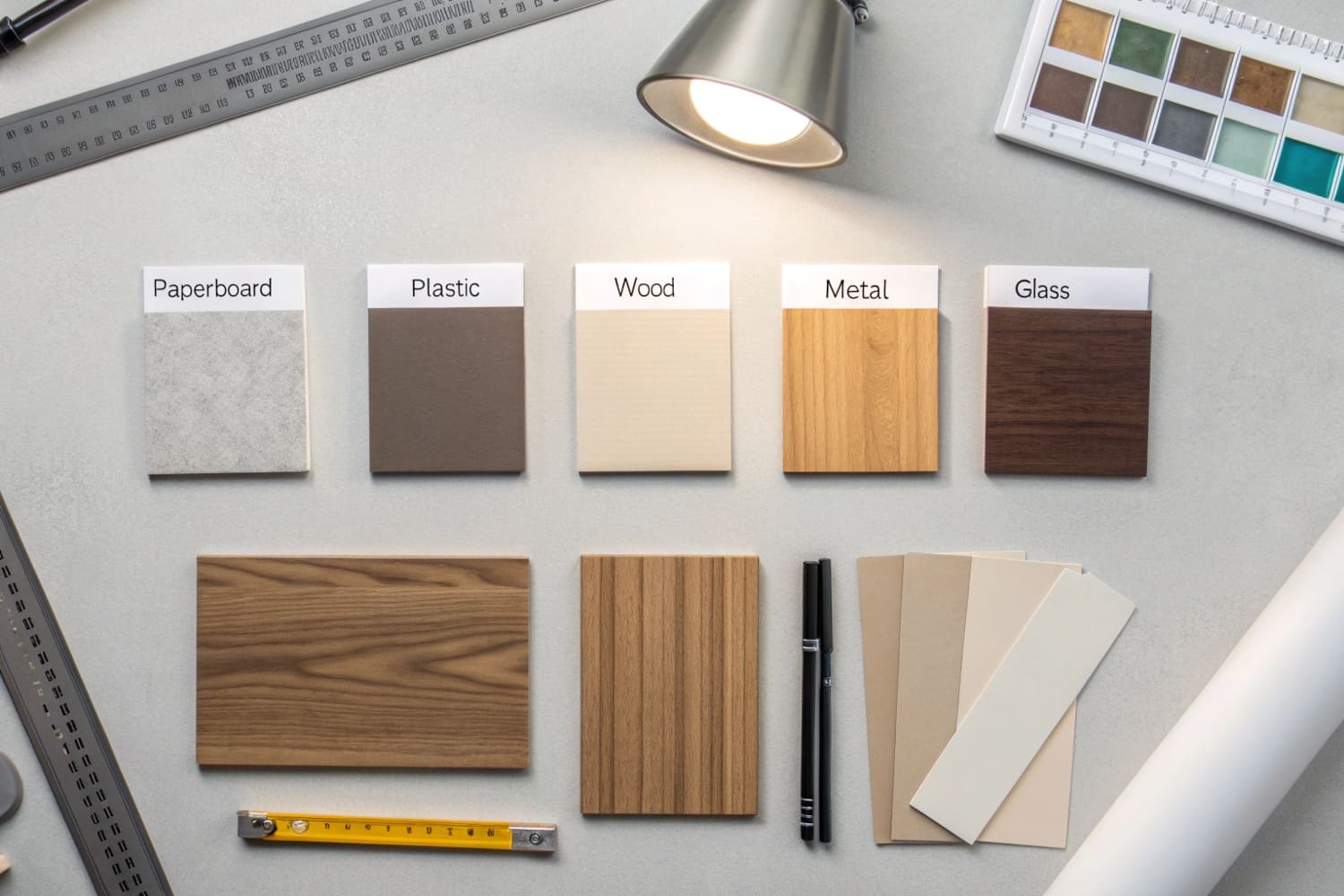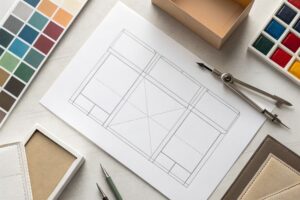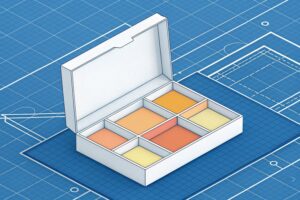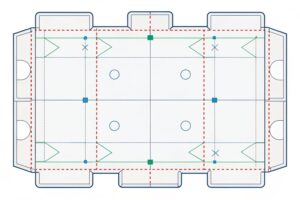I see shoppers pause when a display looks right. They reach. They buy. I design for that moment, then I choose materials that are strong, clean, and easy to print.
Most product display boxes use corrugated cardboard or paperboard as the core, with options like honeycomb board, foam board, plastics, wood, and metal for special loads; surface finishes include water-based coatings, laminates, and eco inks, chosen for strength, print quality, cost, and sustainability.
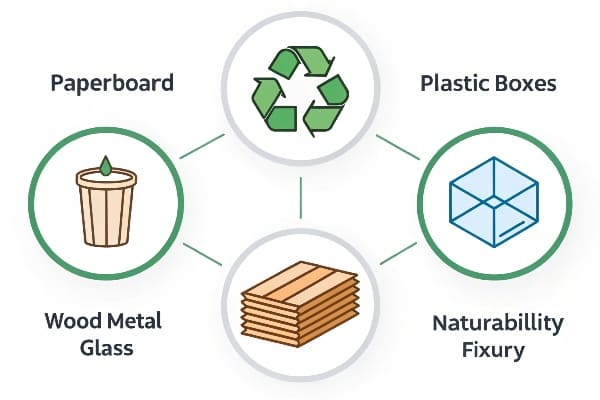
I want you to get a clear path. First, I answer the big questions quickly. Next, I unpack trade-offs with examples from real orders. Stay with me, and you will avoid rework.
What are display boxes made of?
I use a simple rule on projects. I start with paper-based cores. Then I add coatings or reinforcements only when the product or store demands more.
Display boxes are mainly made of corrugated cardboard or paperboard, often with water-based inks and recyclable coatings; premium or heavy-duty needs may add honeycomb board, foam board, plastics, thin metals, or wood parts to increase strength, moisture resistance, and lifespan.

Core materials I choose first
I pick corrugated cardboard1 for most retail displays. It is light. It is strong for its weight. It prints well with flexo or digital. Single-wall E-, B-, or C-flute handles most loads. I go thicker only when the product is heavy or tall. Paperboard works for sleeves, trays, and PDQ inners that sit on shelves. Honeycomb board is my upgrade for bulk, club, or pallet displays that need crush resistance yet stay fiber-based. When a client sells in humid stores or garden centers, I consider waterproof varnish or a thin recyclable film. I stay away from mixed, non-recyclable laminations unless the ROI is clear. In North America, buyers like FSC labels. In Europe, they ask for water-based inks. In APAC, speed and cost push digital print and flat-pack engineering. I test every sample with drop, tilt, and load checks before I print the big run.
| Material | Typical Use Case | Strength/Weight | Printability | Recyclability | Cost Level |
|---|---|---|---|---|---|
| Corrugated (E/B/C) | Floor, PDQ, shippers | High | High | High | Low–Mid |
| Paperboard | Sleeves, trays, inserts | Mid | High | High | Low |
| Honeycomb board | Pallet displays, bulk bins | Very High | Mid | High | Mid |
| Foam board (paper-faced) | Window headers, signs | Mid | High | Medium | Mid |
| Plastic (PP/PET) | Long-life, clear windows | High | Mid | Low–Mid | Mid–High |
What materials are used to make boxes?
I watch costs move with pulp, freight, and tariffs. So I map a “good, better, best” bill of materials before we lock design.
Most boxes use fiber-based boards: corrugated cardboard for structure and paperboard for sleeves or inners; add coatings, reinforcements, or windows as needed to meet load, humidity, and branding targets without overspending.
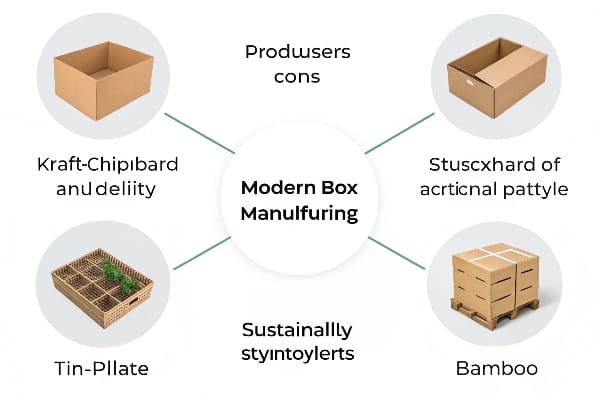
My material stack for cost, speed, and print
I plan three stacks. The “good” stack is single-wall corrugated2 with water-based ink and varnish. It ships flat. It sets up fast. It suits seasonal promotions. The “better” stack adds double-wall3 at stress points, reinforced risers, and an edge-protect insert under heavy SKUs. I use high-hold tabs to cut glue time. The “best” stack targets premium launches. I specify coated top liner for photo print, soft-touch or matte film (recyclable where accepted), metal hooks, and acrylic shelves only if ROI is proven. When a U.S. buyer asked for a crossbow counter display, I ran tests at 10 kg static load for 72 hours. The single-wall failed at the front lip. The fix was a hidden U-channel from honeycomb board and a paperboard compression collar. The price rose by 6%, but the setup time fell, and the sell-through covered it in the first week.
| Stack Level | Board Spec | Finish/Ink | Use Case | Turnaround |
|---|---|---|---|---|
| Good | E/B flute single-wall | Water-based varnish | Seasonal, FMCG, impulse zones | Fast |
| Better | B/C flute mix or reinf. | Matte varnish, spot UV | Heavier SKUs, club trials | Medium |
| Best | Honeycomb + coated liner | Soft-touch, foil, AR | Premium launch, hero bays | Longer |
What material is used for display?
I pick the display surface that meets the shopper first. It must show color right. It must not glare. It must clean easily in store.
Display surfaces use coated liners, SBS paperboard, printable films, or rigid headers; I match finish to lighting and brand tone to keep color accurate, reduce scuffs, and protect edges during handling.

Finishes, liners, and why color stays true
I keep color control simple. I choose white coated liners (C1S/C2S) for vivid photos. I choose kraft liners when the brand wants eco cues. I proof on the real substrate, not just art paper. Under Costco and Walmart lights, glossy films can glare and hide QR codes. So I use satin or matte for wide faces, and reserve gloss for logos. For abrasion, I add a scuff-resistant varnish4 at touch points like shelf lips and tray fronts. If the product leaks oil or lube, I specify an aqueous barrier that stays recyclable. PET windows help visibility for small gear, yet I remove them when the chain bans mixed materials. AR triggers, NFC, and variable QR work well on smooth coatings from digital presses. I keep fonts bold, ink limits safe, and dielines clear. A clean surface saves returns. A stable white point reduces disputes later.
| Surface Type | Visual Effect | Pros | Cons | Notes |
|---|---|---|---|---|
| Coated white liner | Vivid color | Sharp images, brand pop | Shows scuffs if uncoated | Add scuff varnish on edges |
| Kraft liner | Natural look | Eco signal, hides dings | Lower color gamut | Great for outdoor/heritage |
| Matte film | Low glare | Good scan of QR/NFC | Mixed-material recycling | Use only if policy allows |
| Soft-touch | Premium feel | Tactile impact | Marks easily | Spot-use on brand panels |
What are product boxes made of?
I design with the end in mind. I ask where the display lives, how long it runs, and how staff will set it up under time pressure.
Product boxes use corrugated cardboard or paperboard as the base, with inserts, trays, and coatings matched to load, humidity, and shelf life; designs prioritize flat-pack shipping, fast setup, and clean branding.

Structure, lifespan, and tests I run before PO
I plan lifespan first: four weeks, eight weeks, or a quarter. Short runs get single-wall with smart gussets. Longer runs get honeycomb deck5s or hidden ribs. Outdoor or entry zones get moisture shields. I always run three checks. Load test: I stack 1.5× the intended product weight for 48–72 hours. Transport test: I drop from 30–60 cm at corners and edges in flat-pack and built states. Assembly test: I time a store associate who has never seen the design. If setup exceeds seven minutes, I simplify tabs or pre-glue. When I worked on a hunting-accessories launch to meet a strict date, the first sample leaned after weekend traffic. We fixed it with a cross brace and a top cap that locked side panels. The buyer hit the launch date, and the display held shape through the season.
| Design Goal | Material/Feature Choice | Reason |
|---|---|---|
| Fast setup | Auto-lock base, fewer tabs | Cuts training, reduces errors |
| Long life | Honeycomb deck, edge tape | Stops sag, protects corners |
| Moisture zones | Aqueous barrier, PP feet | Reduces wicking from floors |
| Premium print | Coated top liner, satin coat | True color, low glare |
| Cost control | Standard flute, shared dies | Speeds production, lowers waste |
Conclusion
Choose fiber first, match finish to light, test loads early, and keep setup simple. This plan keeps color true, cuts cost, and helps sales move.
Explore the advantages of corrugated cardboard, including its strength, weight, and printability for effective retail displays. ↩
Explore this link to understand why single-wall corrugated is a cost-effective and efficient choice for packaging. ↩
Learn about the advantages of double-wall packaging and how it enhances product protection during shipping. ↩
Learn how scuff-resistant varnish can enhance the durability and appearance of your packaging. ↩
Exploring the advantages of honeycomb decks can enhance your design choices, leading to more efficient and durable products. ↩
